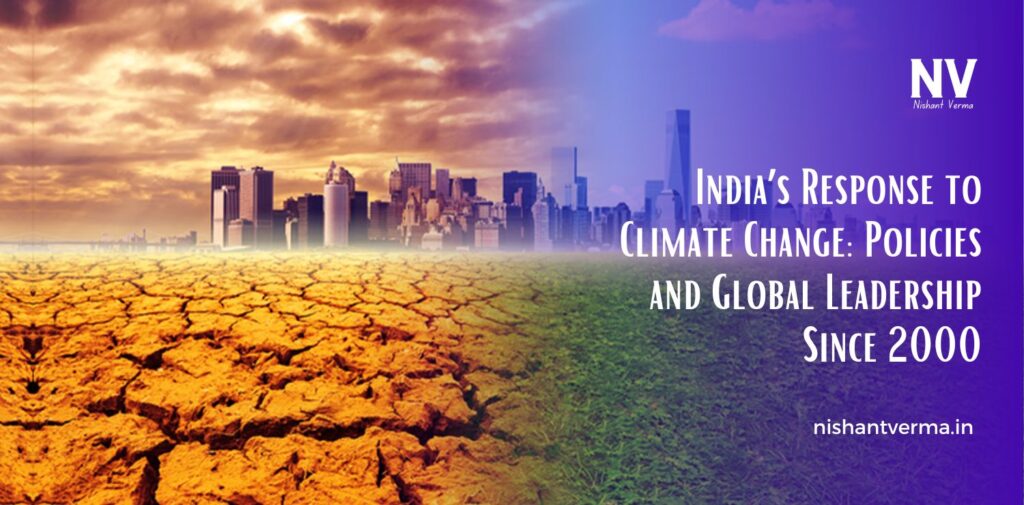India, as one of the world’s largest and most populous countries, has faced the growing challenge of addressing climate change while balancing its development needs. Since the turn of the century, India has become increasingly active in the global conversation on climate change, adopting several policies aimed at reducing its carbon footprint and building resilience against the effects of climate change. Over the years, the nation has taken significant steps in terms of policy-making, international cooperation, and sustainable development, which has established India as an important global leader in the fight against climate change.
India’s Climate Change Awareness and Policy Shift
India response to climate change began to take shape in the early 2000s, when the country started recognizing the growing impact of climate change on its population and economy. The country faced several vulnerabilities, including rising temperatures, erratic rainfall, and extreme weather events, all of which were severely affecting agriculture, water resources, and public health. In this context, India began to develop a more comprehensive approach to environmental protection.
The first major step was the establishment of the National Action Plan on Climate Change (NAPCC) in 2008. This plan laid the foundation for India’s climate change policies and identified eight key national missions to tackle various aspects of climate change, including renewable energy, energy efficiency, sustainable agriculture, water conservation, and afforestation. The NAPCC served as a blueprint for the country’s climate change mitigation and adaptation efforts, ensuring that India’s response was holistic and multifaceted.

India’s Emphasis on Renewable Energy
One of the most significant shifts in India’s climate policy since 2000 has been its focus on increasing the share of renewable energy in the national energy mix. As a country with a growing population and a rising demand for energy, India recognized that transitioning to renewable sources like solar, wind, and hydroelectric power was critical for achieving sustainable development while reducing its carbon footprint.
India made remarkable strides in expanding its renewable energy capacity, with solar power playing a central role. The country’s ambitious target of generating 175 gigawatts (GW) of renewable energy by 2022, including 100 GW from solar, is a testament to its commitment. The government introduced various initiatives such as solar parks, wind energy auctions, and fiscal incentives to encourage investments in the renewable energy sector. By 2020, India became the world’s fourth-largest producer of renewable energy, and it continues to set even more ambitious goals, including achieving 500 GW of renewable energy capacity by 2030.
These efforts have not only contributed to mitigating climate change but have also created job opportunities, improved energy access, and helped reduce air pollution in several regions.

India’s Role in International Climate Negotiations
India has consistently played an active role in international climate negotiations, especially within the United Nations Framework Convention on Climate Change (UNFCCC). As one of the largest emitters of greenhouse gases, India’s position on climate change negotiations has often been central to discussions on global climate action.
India has emphasized the principle of common but differentiated responsibilities (CBDR), which argues that developed countries, having contributed the most to historical emissions, should take greater responsibility in combating climate change. India’s stance has been that, while it acknowledges the importance of reducing emissions, the country’s development needs should not be compromised by ambitious climate targets.
In the 2015 Paris Agreement, India played a pivotal role in shaping the final accord, emphasizing the need for climate finance and technology transfer from developed countries to developing nations. India’s commitment to the agreement included adopting nationally determined contributions (NDCs), which set out voluntary climate targets for the country. These included reducing the carbon intensity of its GDP by 33-35% by 2030, increasing the share of non-fossil fuel-based energy capacity, and enhancing forest cover to absorb carbon dioxide.
Adaptation to Climate Change: Strengthening Resilience
While India has focused heavily on mitigation strategies, it has also recognized the importance of adapting to the already-existing impacts of climate change. Climate change adaptation refers to the efforts made to cope with the effects of rising temperatures, altered rainfall patterns, and extreme weather events. India, being highly vulnerable to these changes, has undertaken several initiatives to increase resilience, particularly in the agricultural and water sectors.
The National Adaptation Fund for Climate Change (NAFCC) was established to support states in addressing local vulnerabilities to climate change. The fund supports projects aimed at improving water management, agricultural practices, coastal zone protection, and disaster resilience. India has also made significant progress in improving its disaster management systems, especially after the devastating effects of events like the 2004 tsunami and the 2013 Uttarakhand floods.
In the agricultural sector, where farmers are particularly vulnerable to shifting weather patterns, the government has focused on climate-resilient crops, better irrigation techniques, and improving weather forecasting to help farmers prepare for changing conditions. The National Mission for Sustainable Agriculture aims to make farming more resilient to climate change and ensure food security for India’s growing population.

India’s Green Finance and Policy Integration
Another significant development in India’s climate response has been the increasing focus on green finance to support the country’s transition to a low-carbon economy. The government has recognized that achieving ambitious climate targets will require substantial investment in renewable energy, energy efficiency, and other green technologies. As a result, India has been promoting policies to attract both domestic and international investments in green projects.
The India Green Bond Market has seen significant growth in recent years, with both private companies and the government issuing green bonds to finance renewable energy and climate adaptation projects. The Reserve Bank of India and the Securities and Exchange Board of India (SEBI) have played key roles in establishing regulatory frameworks to support the development of green finance.
Furthermore, India has integrated climate change considerations into its national development plans. The Niti Aayog, India’s policy think tank, has highlighted the importance of aligning climate action with economic growth and poverty reduction. This approach ensures that India’s climate response is not just about reducing emissions but also about achieving sustainable development goals (SDGs) and improving the quality of life for its citizens.
Challenges and Opportunities Ahead
Despite the progress India has made in addressing climate change, there are still several challenges that the country faces. India’s rapid urbanization and industrial growth continue to put pressure on natural resources, and balancing development with environmental protection remains a delicate task. While renewable energy has made significant strides, fossil fuels, particularly coal, still account for a large portion of India’s energy mix.
Additionally, India’s large and growing population places immense strain on water resources, agriculture, and infrastructure, making climate adaptation efforts all the more critical. While the government has made significant investments in climate resilience, more needs to be done to ensure that vulnerable communities are protected from the impacts of extreme weather events.
At the same time, India’s leadership in climate change can be seen as an opportunity for global collaboration. By continuing to invest in clean energy, green technologies, and sustainable development, India can lead the way in demonstrating how developing countries can tackle climate change without compromising economic growth.
Conclusion: India Response to Climate Change
India response to climate change since 2000 has been multifaceted, encompassing both mitigation and adaptation strategies. The country has made impressive strides in renewable energy, international climate negotiations, and developing green finance mechanisms. While challenges remain, India’s efforts to address climate change reflect its commitment to sustainable development and global climate leadership. As India continues to navigate its path toward a low-carbon future, its role in shaping global climate policy and fostering international collaboration will only grow stronger.




